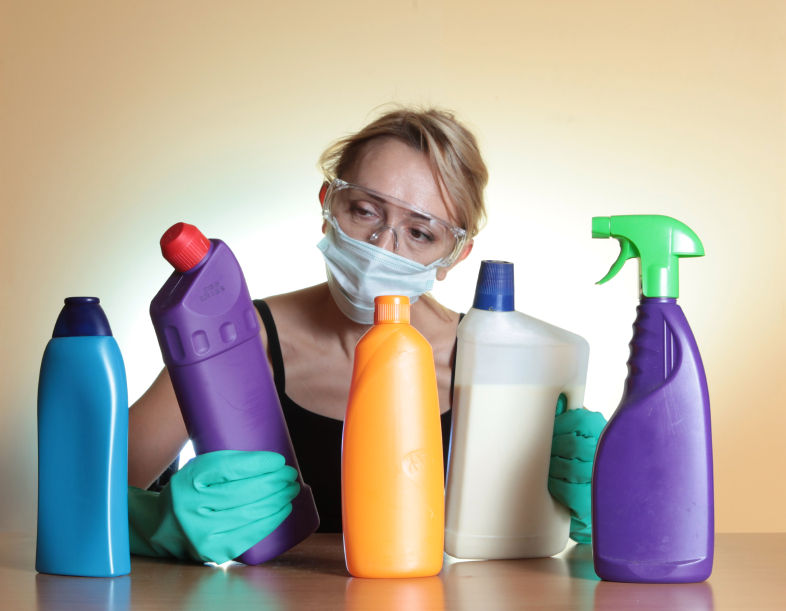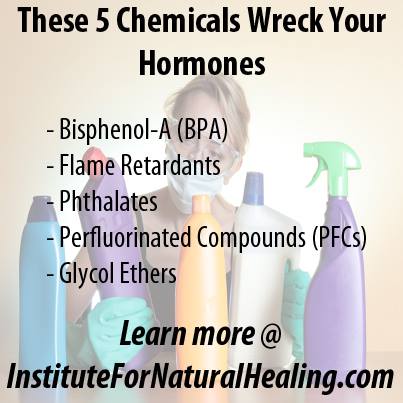Some of the sneakiest—and most dangerous—chemicals are right in your home. They silently damage your hormones without you realizing what’s happening. And you’re probably using them every day.
The more you’re exposed to them, the more danger you are in. They’re hard to avoid. But not impossible.
Here are 5 hormone-damaging chemicals in the products you use every day, along with the ways to avoid them.
1. Bisphenol-A (BPA): We’ve told you that BPA triggers migraines. Worse, it’s an environmental estrogen. It can damage your endocrine system. This can lead to major hormonal disorders and even cancer.
BPA shows up in places you may not realize. Up to 40 percent of major retailers’ sales receipts have a BPA coating on them.1 Even canned foods can contain BPA—whether they’re organic or not. Avoid these receipts, as well as plastics or other products marked “PC” or with recycling label number “7.”
You can also find “BPA-Free” plastics and water bottles. But some ingredients in these alternatives can be even more estrogenic than BPA.2 Your best bets for going BPA-free are reusable glass or metal containers.
2. Flame Retardants: Furniture that won’t catch fire saves lives in an emergency. But one study reviewed by the National Institutes of Health determined that chronic exposure to the chemicals that make furniture flame-retardant may be just as dangerous as the fires they prevent.3 They can cause cancer and damage your thyroid. But it’s not from firsthand contact—like sitting on a sofa.
The chemicals don’t actually bind to the foam that you sit on. Instead, they release into the air and settle in dust. Exposure comes through hand to mouth contact and by breathing it in this dust.4 But you can avoid these toxins by regularly using a HEPA filter vacuum to eliminate dust from your home. Washing your hands frequently is another simple but effective strategy.5
3. Phthalates: You come into contact with them every day. And they could be interfering with your testosterone production. Phthalates are chemicals used to make common plastics. You’ll find them in food containers, children’s toys, air fresheners, cosmetics, and even flooring tiles. But there are simple ways to avoid them.
Look for products that are phthalate-free. Avoid products that contain “fragrance” as an additive. That nice smell is usually made of phthalates. A “3,” “V,” or “PVC” on the packaging is another giveaway. Like the flame retardants, keeping a dust-free home will help reduce these.6
4. Perfluorinated Compounds (PFCs): They’re a family of chemicals that contain fluorine. Like phthalates, you’ll find them in common—and surprising—places. You’ll find PFCs in stain resistant and non-stick materials. These include Teflon products, pizza boxes, microwave popcorn bags, denture cleaners, dental floss, and even shampoo.
Like the other compounds, they mess with hormone production. But what makes these really dangerous is that they can cause liver, pancreatic, testicular, and mammary tumors. To get away from PFCs, avoid non-stick cookware, waterproof clothing, and moisturizers with the word “fluoro” anywhere in the ingredients.7 You can even find PFC-free, organic dental floss in some health stores and online.
5. Glycol Ethers: They’re a class of chemicals that can cut through grease and grime. It’s why they’re in so many household cleaning products. But low-level exposure causes damage to sperm and testicles.8 And cleaning solutions aren’t the only place you’ll find glycol ethers.
They’re also in perfumes and soaps. You’ll even see them in processed foods like soda, cake mix, and salad dressing.9 The best way to avoid them is to find natural cleaning products. But you have to read the label. Even cleaners that claim to be “green” can still have glycol ethers in them. You can get the same results (but safer) by using a homemade mix of water, vinegar, and lemon juice.10
Any one of these hormone disruptors on its own is bad enough. But chances are you’re being exposed to high amounts of these chemicals combinations several times a day—without even realizing it. Knowing the familiar names to look out for will let you take control of your hormones back from these dangerous offenders.
Like this Article? Forward this article here or Share on Facebook.
References:
1http://www.ewg.org/bpa/
2http://www.motherjones.com/environment/2014/03/tritan-certichem-eastman-bpa-free-plastic-safe?page=2
3http://greensciencepolicy.org/wp-content/uploads/2013/11/Review-of-Env-Health-2542010-SHAW-BLUM-.pdf
4http://greensciencepolicy.org/topics/health-environment/
5http://greensciencepolicy.org/wp-content/uploads/2013/11/ReduceToxicsFlyer-2013SEPT.pdf
6http://www.nrdc.org/living/chemicalindex/phthalates.asp?gclid=CMnn4cHwuboCFQhgMgodM3kARQ
7http://www.saferchemicals.org/resources/chemicals/pfc.html
8http://www.alternet.org/story/148963/if_you_knew_how_dangerous_green_cleaning_products_were%2C_you%27d_probably_go_back_to_soap_and_water?page=entire
9http://www.ecospecifier.com.au/knowledge-green/articles/propylene-glycol-glycol-ethers.aspx
10http://homeguides.sfgate.com/natural-homemade-streakfree-window-cleaners-78848.html


